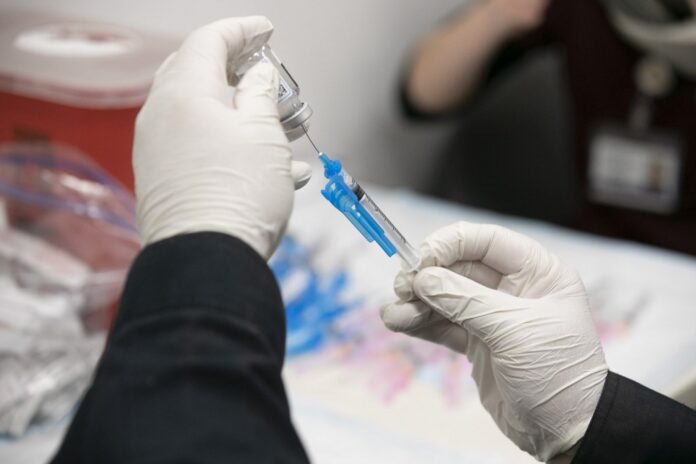
By Ana B. Ibarra
Gov. Gavin Newsom announced today that all Californians 50 and older will be eligible to be vaccinated on April 1, while everyone 16 and older will qualify two weeks later.
The governor also said that starting today, the state will loosen requirements in lower-income communities for doctors and other health care providers to use their discretion to vaccinate anyone they think should get one, regardless of age or medical condition.
The state expects a surge in supply next month: approximately 2.5 million first and second doses of COVID-19 vaccinations per week in the first half of April, and more than 3 million in the second half of the month.
That is a substantial increase from the 1.8 million doses the state receives per week. Health officials have long said supply was the biggest constraint, and that the state has capacity to administer about 3 million vaccines per week and should be able to administer up to 4 million by the end of April.
As of Wednesday, California had administered 15.5 million doses. About 5.4 million people have been fully vaccinated.
The expansion means that the state is about to open up to vaccinating all adults. It comes before May 1, when President Joe Biden had anticipated the move nationwide.
Even with this expansion in eligibility and supply, it will take several months to vaccinate everyone who wants a vaccine, health officials warn.
It also is likely to spur a rush for appointments, leaving many people frustrated that they are unable to line up vaccinations.
Some counties have already been expanding the list of who is eligible. Solano County opened up vaccines to residents 50 and older last week. Contra Costa followed this week and today Tulare County and Long Beach made a similar announcement.
But health officials in Santa Clara County said that while they’ll expand vaccinations to people 50 and older starting April 1, and to everyone April 15, there’s still far too few doses available.
Dr. Marty Fenstersheib noted at a briefing today that the county has about 400,000 residents aged 50 to 64, but it only will get 58,000 doses next week despite having the capacity to vaccinate as many as 200,000 people.
“We are concerned,” said Fenstersheib, the county’s COVID vaccine and testing officer. “We really just want to caution people to please continue to be patient” as they seek appointments.
Sutter Health, one of California’s largest health systems, can vaccinate more than 25,000 patients daily but also has too few doses to meet demand, said spokeswoman Angeline Sheets.
Providers in communities like Santa Ana — those that fall in the lowest half of the Healthy Places Index — will have the flexibility to use their judgment. “If someone comes in who is eligible under the existing conditions, but with a family member, we will accommodate the family member, no questions asked,” Newsom said.
The idea is to more quickly vaccinate families and people who live together in communities that were disproportionately affected by COVID-19.
Previously, Californians 65 and over and people with certain serious health conditions were eligible, along with health care workers, educators, food industry workers and a few other types of essential workers.
The state has largely followed guidelines from the Centers for Disease Control and Prevention on vaccine prioritization. Still, the state has received some pushback on its vaccination game plan — most recently, people with some underlying medical conditions questioned why their conditions were left out. People with Type 2 diabetes, for example, are eligible now, but not those with Type 1 diabetes, which is usually diagnosed early in life and is related to an autoimmune reaction.
With today’s announcement, people with medical conditions not on the state’s high-risk list may have to compete for vaccines with the general population.
Kaili Kobylka, 28, was diagnosed with Type 1 diabetes less than two years ago, so her condition was still new to her when the pandemic hit. She’s still waiting anxiously for her turn to get the vaccine, she said.
“It’s frustrating, I’ve been trying to get a vaccine for a couple of months, but I wasn’t eligible,” Kobylka said.
While Napa County, where she lives, hasn’t opened up vaccines to people with Type 1 diabetes, her provider, Kaiser Permanente, recently did. She’s been checking the Kaiser website for appointments, but hasn’t been able to find open slots near her.
When Kobylka gets sick, it becomes more difficult for her to control her blood sugars. “I take tons of insulin but I don’t see my numbers come down,” she said. “I know that’s the case when I have a cold or the flu, but I have no idea how my body would respond to COVID.”
People with qualifying medical conditions do not have to provide a doctor’s note or verification of their medical conditions; they can self attest. And while it’s tempting to lie, it’s also a moral issue, Kobylka said. “I don’t feel great lying.”
The state’s expansion means Newsom himself will be eligible for a vaccine next Thursday. He said he would take whichever vaccine is available for him, acknowledging concerns that some vaccines are better than others.
Newsom said that the state’s effort to distribute vaccines equitably continues to be a priority. The state currently reserves 40% of its vaccine supply for lower-income, hard-hit communities in an attempt to address the inequities. About 19% of the state’s vaccines have been administered in the poorest ZIP codes, compared to 30% in wealthier communities.
Barbara Feder Ostrov contributed to this article.


